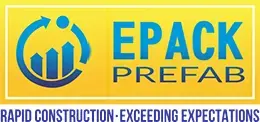In the growing construction and cold chain industries, insulated sandwich panels have become an essential building material—offering superior thermal insulation, speed of construction, and durability. But when it comes to manufacturing these panels, not all production methods are the same.
There are two major types of production technologies for sandwich panels:
- Continuous Panel Lines
- Discontinuous Panel Lines
Each has its own advantages and ideal use cases. In this post, we’ll break down the key differences between them and help you understand why EPACK Prefab’s Continuous PUFF Panel Lines gives your projects a competitive edge—especially in quality and scalability.
🏭 What is a Discontinuous Panel Line?
A discontinuous panel line produces panels in batches, where each panel is individually injected and pressed in a mold. The process involves:
- Loading and closing a mold
- Injecting polyurethane foam
- Allowing it to cure
- Opening the mold and demolding the panel
This method is labor-intensive and time-consuming, but it offers some flexibility for small-scale production.
✅ Advantages of Discontinuous Panel Lines:
- Ideal for custom sizes or low-volume production
- Lower initial capital investment
- Easier to start with in emerging markets or for startups
❌ Limitations:
- Slower production speed
- Higher manual intervention, leading to variation in panel quality
- Increased curing time
- Not suitable for large or urgent infrastructure projects
⚙️ What is a Continuous Panel Line?

A continuous panel line is a fully automated system that produces panels in a streamlined, nonstop process. Steel sheets are uncoiled, fed into the line, foam is injected between them, and panels are cured and cut to length—all without stopping the machine.
This technology is ideal for mass production, especially in industries like:
✅ Advantages of Continuous Panel Lines:
- High-speed production: Thousands of square meters per shift
- Consistent quality with minimal variation
- Customizable panel length and thickness with greater precision
- Smooth surface finish and better joint profiles
- Lower operational cost per panel over time
- Ideal for bulk and large-scale infrastructure projects
❌ Limitations:
- Higher upfront investment
- Best suited for standardized panel dimensions
🔬 Key Differences at a Glance:
| Feature | Discontinuous Panel Line | Continuous Panel Line |
| Production Type | Batch-wise | Continuous |
| Output Speed | Low | High |
| Quality Consistency | Variable | Uniform |
| Manpower Requirement | High | Low |
| Customization | More flexible for small runs | Ideal for large orders |
| Surface Finish | Moderate | Superior |
| Investment | Lower | Higher (but better ROI long-term) |
🏗️ Why EPACK Prefab Choose Continuous Panel Line Technology
At EPACK Prefab, we understand the rising demand for high-quality PUFF and insulated panels, especially across South India. That’s why we’ve installed a fully automated Continuous PUFF Panel Line at our Mambattu facility near Sricity, Andhra Pradesh.
This facility allows us to:
- Deliver precision-engineered panels at scale
- Meet project timelines faster
- Ensure superior thermal insulation and joint tightness
- Serve clients across Andhra Pradesh, Tamil Nadu, Karnataka, and Kerala with lower logistics cost
✅ Conclusion
Whether you’re a contractor, architect, or cold chain operator, understanding the difference between continuous and discontinuous panel production can help you make better decisions for your infrastructure projects.
For large-scale, fast-paced, and quality-critical applications, continuous panels are the future—and EPACK Prefab is proud to lead the way in adopting this world-class manufacturing technology in India.
📞 Want to Know More?
Visit us at www.epack.in or
📩 Contact us through our email id: enquiry@epack.in
📞 Call us at +91 8130 444 466 to discuss your next panel requirement!











